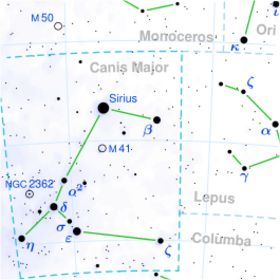Astronomy:UW Canis Majoris
| Observation data Equinox J2000.0]] (ICRS) | |
|---|---|
| Constellation | Canis Major |
| Right ascension | 07h 18m 40.37894s[1] |
| Declination | −24° 33′ 31.3182″[1] |
| Apparent magnitude (V) | 4.95[2] (4.82 - 5.33[3]) |
| Characteristics | |
| Spectral type | O7.5-8Iabf + O9.7Ib[4] |
| U−B color index | −1.00[2] |
| B−V color index | −0.15[2] |
| Variable type | Beta Lyrae[3] |
| Astrometry | |
| Radial velocity (Rv) | 20[5] km/s |
| Proper motion (μ) | RA: −2.865[1] mas/yr Dec.: +3.678[1] mas/yr |
| Parallax (π) | 0.8549 ± 0.1277[1] mas |
| Distance | approx. 3,800 ly (approx. 1,200 pc) |
| Absolute magnitude (MV) | −6.1[6] |
| Orbit[7] | |
| Period (P) | 4.39 days |
| Semi-major axis (a) | 34-48 R☉ |
| Eccentricity (e) | 0 |
| Inclination (i) | 71.0-71.6° |
| Longitude of the node (Ω) | 3.3-4.5° |
| Details | |
| UW CMa A | |
| Mass | 11-44 M☉ |
| Radius | 12-20[7] R☉ |
| Luminosity | 170,000-450,000[7] L☉ |
| Temperature | 33,750[7] K |
| UW CMa B | |
| Mass | 17-33[7] M☉ |
| Radius | 14-17[7] R☉ |
| Luminosity | 240,000-330,000[7] L☉ |
| Temperature | 33,300-33,700[7] K |
| Other designations | |
| Database references | |
| SIMBAD | data |
UW Canis Majoris is a star in the constellation Canis Major. It is classified as a Beta Lyrae eclipsing contact binary and given the variable star designation UW Canis Majoris. Its brightness varies from magnitude +4.84 to +5.33 with a period of 4.39 days.[8] Bode had initially labelled it as Tau2 Canis Majoris, but this designation had been dropped by Gould and subsequent authors.[9]
UW Canis Majoris A is a rare blue supergiant of spectral type O7.5-8 Iab. The precise characteristics of the system are still uncertain, in part because the spectral signature of the secondary is very hard to disentangle from the spectrum of the primary and the surrounding envelope of stellar wind. A detailed spectral study by Gies et al. found that the primary had a diameter 13 times that of the Sun, while its secondary companion is a slightly cooler, less evolved and less luminous supergiant of spectral type O9.7Ib that is 10 times the Sun's diameter. According to this study, the brighter star is the more luminous, its luminosity 200,000 times that of the Sun as opposed to the secondary's 63,000 times. However the secondary is the more massive star at 19 Solar masses (M☉) compared to the primary's 16 M☉.[4]
However, a more recent photometric analysis finds several configurations of mass and luminosity ratios that match the observed data.[7]
Parallax measurements showed it to be approximately 3,000 light years from Earth, but this is unexpectedly close for a star of its spectral type and brightness. More accurate Hipparcos parallax data gives an even closer result around 2000 light years,[10] but Gaia Data Release 3 gives a parallax of 0.85±0.13 mas,[1] corresponding to a distance of around 3,800 light years. It is thought to be a distant member of NGC 2362 which would place it about 5,000 light years and more closely match its expected luminosity. The contradiction between the different distance results is still a subject of research.[6]
References
- ↑ 1.0 1.1 1.2 1.3 1.4 1.5 Vallenari, A. et al. (2022). "Gaia Data Release 3. Summary of the content and survey properties". Astronomy & Astrophysics. doi:10.1051/0004-6361/202243940 Gaia DR3 record for this source at VizieR.
- ↑ 2.0 2.1 2.2 Ducati, J. R. (2002). "VizieR Online Data Catalog: Catalogue of Stellar Photometry in Johnson's 11-color system". CDS/ADC Collection of Electronic Catalogues 2237. Bibcode: 2002yCat.2237....0D.
- ↑ 3.0 3.1 Samus, N. N. et al. (2009). "VizieR Online Data Catalog: General Catalogue of Variable Stars (Samus+ 2007-2013)". VizieR On-line Data Catalog: B/GCVS. Originally Published in: 2009yCat....102025S 1. Bibcode: 2009yCat....102025S.
- ↑ 4.0 4.1 Bagnuolo, William G. Jr.; Gies, Douglas R.; Hahula, Michael E.; Wiemker, Rafael; Wiggs, Michael S. (1994). "Tomographic Separation of Composite Spectra. 2: The Components of 29 UW Canis Majoris". The Astrophysical Journal 423: 446–55. doi:10.1086/173822. Bibcode: 1994ApJ...423..446B.
- ↑ Pourbaix, D.; Tokovinin, A. A.; Batten, A. H.; Fekel, F. C.; Hartkopf, W. I.; Levato, H.; Morrell, N. I.; Torres, G. et al. (2004). "SB9: The ninth catalogue of spectroscopic binary orbits". Astronomy and Astrophysics 424 (2): 727–732. doi:10.1051/0004-6361:20041213. Bibcode: 2004A&A...424..727P.
- ↑ 6.0 6.1 Kaltcheva, N. T.; Hilditch, R. W. (2000). "The distribution of bright OB stars in the Canis Major-Puppis-Vela region of the Milky Way". Monthly Notices of the Royal Astronomical Society 312 (4): 753. doi:10.1046/j.1365-8711.2000.03170.x. Bibcode: 2000MNRAS.312..753K.
- ↑ 7.0 7.1 7.2 7.3 7.4 7.5 7.6 7.7 7.8 7.9 Antokhina, E. A.; Rao, M. Srinivasa; Parthasarathy, M. (April 2011). "Light curve analysis of Hipparcos data for the massive O-type eclipsing binary UW CMa". New Astronomy 16 (3): 177–182. doi:10.1016/j.newast.2010.09.008. Bibcode: 2011NewA...16..177A.
- ↑ Hutchings, J.B. (1977). "The Massive Hot Binary 29 Canis Majoris". Publications of the Astronomical Society of the Pacific 89 (531): 668–74. doi:10.1086/130206. Bibcode: 1977PASP...89..668H.
- ↑ Wagman, Morton (2003). Lost Stars: Lost, Missing and Troublesome Stars from the Catalogues of Johannes Bayer, Nicholas Louis de Lacaille, John Flamsteed, and Sundry Others. Blacksburg, VA: The McDonald & Woodward Publishing Company. p. 74. ISBN 978-0-939923-78-6.
- ↑ Van Leeuwen, F. (2007). "Validation of the new Hipparcos reduction". Astronomy and Astrophysics 474 (2): 653–664. doi:10.1051/0004-6361:20078357. Bibcode: 2007A&A...474..653V.
 |




